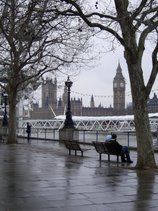
YesBut’s Golden Rule of purchasing:
“
If you can afford it, buy the cheapest”.
Contrary to popular belief the rule isn’t entirely influenced by me being a DOWM ~ “
Devote Old Welsh Miser“. If you read yesterday’s blog you will see, it is based on experience and logic.
Film or digital camera? Do they still make film?
O.K. you want to buy a digital camera. Which one should you buy?
There are two main types: Compact and Single Lens Reflex (SLR). Applying the Golden Rule, on cost consideration alone, your first camera should be a compact. SLRs cost between £250 to over£3,000 (US$500 ~ $6,000). While you can buy a reasonable compact for less than £100 ($200). Also compacts as the name implies are small and easily carried in your pocket or bag, while SLRs are bulky and heavy.
Now for the first peace of techno speak. The choice of number of pixels - pictures are made up of a number of dots (pixels), the higher the number the sharper clearer the picture. Cameras range from 1M pixel to 10M. If you are going to view your pictures on a computer a 3M pixel camera will be adequate.
That’s all the technical stuff you need to know. But, just for interest you will come across reference to
“optical” and
“digital” zoom:
Optical zoom - you can zoom in on the subject of you picture, without loss of picture quality - useful but not essential.
Digital zoom - the image is made to look larger but at the expense of picture quality - completely useless, you will get better results later, using a basic picture editing program on your computer.
You go to the camera shop and there are two 3M digital cameras, one costs £50 the other £80, which one to buy?
Two questions to answer:
Which one feels most comfortable to hold and handle?
How quick is their response time?
Unlike a film camera, which, when you press the button, the photograph is taken immediately. Digital cameras have a slight delay between pressing the shutter button and the picture being taken. The response delay isn’t very critical, if like on Wednesday’s blog, you are taking a photograph of a monument - its been there for 150 years and is unlikely to move in the next 3 seconds! But if you are taking action shots, its crucial.
I learnt this when trying to photograph the City of London Lords Mayor Show. Nice photo of soldiers on horse back, click - delay, result a photo of a horses tail!!!
How can you measure a camera’s response time?
 If you have a watch with a second hand, or a digital timer. Take a photo of the watch, pressing the button when the second hand is pointing at 12. Put the camera in view mode and you will see in the camera’s LCD screen the photograph taken ~ you will see from the photo the length of delay to when the photograph was actually taken. Choose the camera with the smallest delay. A lot can happen in 3 seconds!!
If you have a watch with a second hand, or a digital timer. Take a photo of the watch, pressing the button when the second hand is pointing at 12. Put the camera in view mode and you will see in the camera’s LCD screen the photograph taken ~ you will see from the photo the length of delay to when the photograph was actually taken. Choose the camera with the smallest delay. A lot can happen in 3 seconds!!
You will note the olden rule also applies for the purchase of watches - cheap watch only tells the time, no: date, stopwatch, alarm functions. It cost £5, five years ago, since purchase its had three new straps and four new batteries, but it only loses 1 second a day.
So you’ve bought your cheap camera, what next? Use it! Don’t just use it on special occasions and holidays. Its compact, carry it around with you when you go to work, shopping or on walks.
If you soon get fed up of using it, then look at the money you have saved by applying YesBut’s Golden Rule - “
If you can afford it, buy the cheapest“. However, if you really get pleasure from taking photos, even a basic camera will be sufficient to allow you to learn and improve your photographic techniques. You will learn what you like photographing, and should you decide to buy a more expensive camera, the experience gained will help you with its selection.
Click here to see a photograph taken using YesBut’s cheap camera















